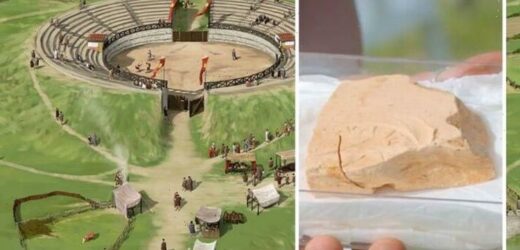Archeologists discover ‘very special’ Roman stamp
We use your sign-up to provide content in ways you’ve consented to and to improve our understanding of you. This may include adverts from us and 3rd parties based on our understanding. You can unsubscribe at any time. More info
Britain changed forever in 43AD, making the British Isles part of the largest empire the world had ever seen. Prior to the arrival of the Romans, Britain had been divided into tribal areas. But the Romans galvanised Britain, bringing a new culture, new currency, a new language and new gods to worship.
Silchester Roman Town, or Calleva Atrebatum as it was once known, had been the capital of the Atrebates tribe.
It became a large and important Roman town, serving as a major crossroads in the Roman roads of Britain, before its abandonment between the 5th and 7th Centuries.
Silchester became a bustling town crammed with shops, homes, public baths and an amphitheatre.
Unlike most Roman towns, it was never re-occupied or re-built, and lay beneath the ground for the best part of 1500 years.


Archaeologists have been digging at the site, considered one of the best preserved in the UK, each summer for the last 20 years.
In the southeast of the town stood the thermal baths, which were explored by Channel 5 documentary ‘Digging for Britain’s Past’.
Teams digging at the Hampshire site scrutinised every inch of soil, tile by tile, and brick by brick, leading to some fascinating discoveries.
One such discovery was a stamped tile with the name and title of the emperor Nero, the fifth Roman emperor who famously “fiddled while Rome burned”.

Dr Sara Machin, Roman tile expert at the University of Reading, told the documentary: “It’s a full circular stamp that comes round, and it’s got Nero Claudius Caesar Augustus Germanicus.”
The clearest part of the stamp is the ‘Ger’ for Germanicus.
Dr Machin continued: “Because it’s Nero, this gives us a really tight date. It’s very special and gives us so much new information about the bath house than we ever thought we would get.”
Nero came to power just 11 years after the Roman conquest of Britain.
DON’T MISS:
Stonehenge stunned researchers after ‘fascinating’ remains [INSIGHT]
Archaeology: Treasure hunter’s claim he found Nazi U-boat full of gold [DISCOVERY]
Archaeologists find link between Halley’s Comet and Christianity [REVEALED]

The tile, therefore, dates the Silchester site right back to the beginnings of the Roman occupation.
Alex Langlands, an archaeologist and co-presenter of the Channel 5 series, explored whether the answers behind Nero’s determination to stamp his mark on Silchester may lie in the events that happened in Britain during his reign.
Glynn Davis, curator at Colchester Museum, said that upon Roman arrival in Britain, they turned on Queen Boudicca and treated her and everyone else “like newly conquered people”.
They took away their lands and their wealth, sparking fury amongst Boudicca and the British Iceni tribe.

Mr Davis said: “Boudicca raised forces. The Iceni, her tribe, joined with the Iron Age Brits of Essex, the Trinovantes, and they came and they stormed Colchester.
“They took it almost by surprise and they slaughtered everyone. They pillaged, they plundered.”
Boudicca’s revolt proceeded to target Londoninum (modern London) and Verulamium, a town southwest of modern day St Albans.
An estimated 70,000-80,000 Romans and Britons were killed in Boudicca’s conquest.
Eventually the Romans rallied and overwhelmed the British troops, who could not compete with the armoury their Roman opposition boasted.
Mr Davis continued: “Nero even considered abandoning the British project, it was that much of a setback.”
Evidence at Silchester suggests that the site became a hive of activity after victory over Boudicca.
Only two excavation sites in the UK have produced Nero tiles — Silchester and Little London, just over a mile away.
Professor Michael Fulford led a dig at the site in 2017. He said the tiles “add to the evidence that Nero saw Silchester as a pet project where he could construct extravagant buildings, like those seen in Rome, to inspire awe among his subjects in the UK”.
Source: Read Full Article


